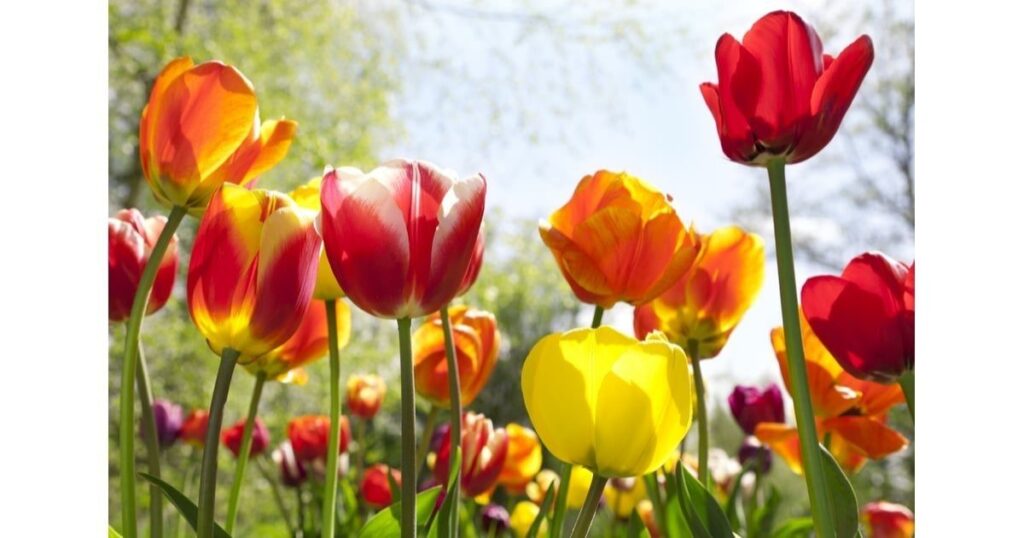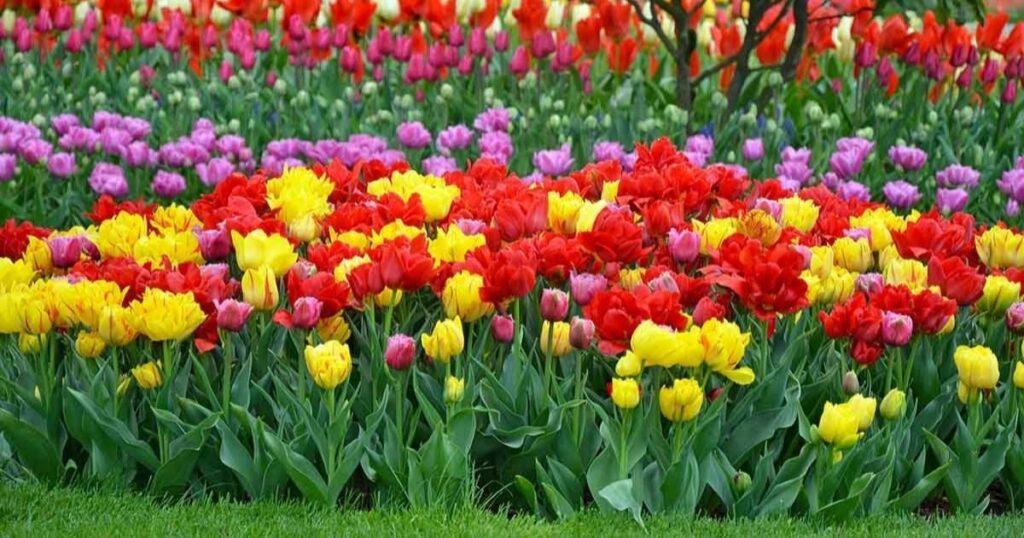Tulips are iconic spring flowers that bring a burst of color and elegance to gardens around the world. While traditionally planted in the fall, many gardeners wonder if it’s possible to plant tulip bulbs in the spring. This comprehensive guide will explore the possibilities, challenges, and techniques for spring tulip planting, helping you achieve beautiful blooms even if you’ve missed the conventional planting window.
Understanding Tulip Bulb Planting
Before delving into spring planting, it’s essential to understand the typical life cycle of tulips and why fall planting is usually recommended.
Why Fall is Traditionally Preferred
Tulip bulbs are typically planted in the fall for several reasons:
- Dormancy period: Fall planting allows bulbs to experience a necessary period of cold dormancy, crucial for proper root development and flower formation.
- Root establishment: Cooler soil temperatures in autumn promote strong root growth before the ground freezes, giving bulbs a head start for spring growth.
- Natural cycle: Fall planting aligns with the tulip’s natural growth cycle, mimicking how wild tulips propagate in nature.
- Spring energy reserves: By planting in the fall, bulbs can store energy throughout winter, leading to more vigorous growth and larger blooms in spring.
Spring Planting: Breaking the Norm
While fall planting is ideal, spring planting of tulip bulbs is possible under certain conditions:
- Late delivery or purchase: If you receive bulbs too late for fall planting or find them on sale in spring, you can still plant them.
- Mild winter regions: Spring planting might be more feasible in areas with warmer winters.
- Experimental gardening: Some gardeners enjoy testing different planting times to observe the results.
When considering spring planting, remember that the results may differ from fall-planted tulips. Blooms might be smaller or appear later in the season. However, you can still achieve beautiful tulip displays with proper care and technique.
The Right Time for Planting in Spring

Timing is crucial when planting tulip bulbs in spring. Let’s explore the factors that influence the best planting time.
Understanding Your Local Climate
Local climate plays a significant role in determining the optimal planting time:
- In cooler regions, plant as soon as the ground thaws and becomes workable.
- In warmer areas, you may need to plant earlier to give bulbs enough time to establish before hot weather arrives.
Ideal Soil Conditions
Soil temperature and moisture are critical factors:
- Aim for soil temperatures around 55°F (13°C) or slightly cooler.
- Ensure the soil is well-draining to prevent bulb rot.
Early Spring Planting
In most regions, early spring is the best time for planting tulip bulbs:
Also read this post:will explore the best shade-loving herbs
- This typically falls between late March and early April.
- The goal is to give bulbs enough time to establish roots before summer heat arrives.
Late Frost Considerations
Be mindful of potential late frosts:
- Keep an eye on weather forecasts.
- Be prepared to protect emerging shoots with mulch or garden fleece if late frosts are predicted.
Timing for Specific Zones
Planting times can vary based on your hardiness zone:
- Warmer zones (8-10): Plant in late February to early March.
- Cooler zones (3-7): Wait until mid-April when the risk of hard frost has passed.
Adjusting for Unusual Weather Patterns
Climate variability may require adjustments:
- Monitor local weather patterns closely.
- Be flexible with your planting schedule if spring arrives earlier or later than usual.
Preparing for Spring Planting

Proper soil preparation is crucial for the success of spring-planted tulip bulbs.
Assessing Soil Quality
Start by evaluating your soil:
- Tulips prefer well-draining, fertile soil.
- Conduct a soil test to determine nutrient levels and pH.
Enriching the Soil
Improve soil quality for optimal tulip growth:
- Add organic matter like compost or well-rotted manure to enhance fertility and structure.
- For poor soils, consider incorporating a balanced, slow-release fertilizer.
Checking Soil pH
Tulips thrive in slightly acidic to neutral soil:
- Aim for a pH between 6.0 and 7.0.
- Adjust pH using lime (to increase) or sulfur (to decrease) if necessary.
Preparing the Planting Site
Create an ideal environment for your tulip bulbs:
- Choose a sunny location with at least 6 hours of direct sunlight daily.
- Clear the area of weeds and debris.
- Loosen the soil to a depth of 12 inches to promote root growth.
Considering Pots or Raised Beds
For challenging soil conditions or limited space:
- Use containers with good drainage holes.
- Opt for raised beds filled with high-quality potting mix.
Watering Before Planting
Prepare the soil moisture:
- Lightly water the planting area before inserting bulbs.
- This helps create a welcoming environment for root development.
Planting Process and Techniques
Follow these steps to plant your tulip bulbs successfully in spring.
Choosing the Right Bulbs
Select high-quality bulbs for the best results:
- Look for firm, plump bulbs without signs of mold or damage.
- Larger bulbs typically produce larger flowers.
Timing of Planting
Plant as early in spring as possible:
- Wait until the soil is workable and not waterlogged.
- Aim to plant before daytime temperatures consistently exceed 70°F (21°C).
Planting Depth and Spacing
Proper depth and spacing are crucial:
- Plant bulbs 6-8 inches deep.
- Space bulbs 4-6 inches apart.
- For rows, maintain 12 inches between each row.
Orientation of the Bulbs
Plant bulbs correctly for optimal growth:
- Place the pointed end facing upwards.
- The flatter side with root remnants should be at the bottom.
Soil Cover and Initial Watering
Finish planting with care:
- Cover bulbs with soil, gently firming to remove air pockets.
- Water moderately to settle the soil around the bulbs.
Mulching for Temperature Control
Apply mulch to regulate soil conditions:
- Use a 2-3-inch layer of organic mulch.
- This helps maintain moisture and stabilize soil temperature.
Care After Planting
Provide initial care to support growth:
- Keep soil consistently moist but not waterlogged.
- Monitor for emerging shoots and protect from late frosts if necessary.
Adjusting Techniques for Container Planting
When planting in containers:
- Ensure excellent drainage in pots.
- Use high-quality potting mix.
- Follow similar depth and spacing guidelines as in-ground planting.
Caring for Spring-Planted Tulips

Proper care is essential for the success of your spring-planted tulips.
Sunlight Requirements
Provide adequate sunlight:
- Tulips need 6-8 hours of direct sunlight daily.
- Choose a south-facing location for optimal sun exposure.
Watering Regimen
Maintain proper soil moisture:
- Water deeply immediately after planting.
- Once shoots appear, water regularly, especially during dry spells.
- Avoid overwatering to prevent bulb rot.
Fertilizing for Growth
Support tulip growth with appropriate fertilization:
- Apply a balanced, slow-release bulb fertilizer at planting time.
- Reapply when shoots emerge.
- Avoid high-nitrogen fertilizers that may promote leaf growth at the expense of flowers.
Mulching for Moisture and Temperature Control
Use mulch to create a stable environment:
- Apply a 2-3 inch layer of organic mulch around plants.
- This helps retain moisture and regulate soil temperature.
Dealing with Pests and Diseases
Monitor and protect your tulips:
- Watch for common pests like aphids and bulb mites.
- Prevent fungal diseases by ensuring good air circulation.
- Avoid overhead watering to reduce disease risk.
Post-Blooming Care
Properly care for tulips after flowering:
- Remove spent flowers to prevent energy expenditure on seed production.
- Leave foliage intact until it yellows and dies back naturally.
Preparing for Dormancy
Help tulips transition to dormancy:
- Once the foliage has yellowed, gently remove it.
- For potted tulips, consider lifting and storing bulbs in a cool, dry place over the summer.
Annual Replanting Considerations
Decide on your long-term tulip strategy:
- Some gardeners treat spring-planted tulips as annuals.
- If desired, replant new bulbs each year for consistent blooming.
FAQs
What is the latest you can plant tulip bulbs?
The latest time to plant tulip bulbs is typically early spring, as soon as the ground is workable. However, for best results, aim to plant them as early in spring as possible to give them ample time to establish before the heat of summer arrives.
Can I put tulip bulbs in spring?
Yes, you can plant tulip bulbs in spring, although it’s less conventional than fall planting. Spring-planted tulips may bloom later and potentially less vigorously than fall-planted ones, but with proper care, you can still achieve beautiful flowers.
Do tulips bloom in early spring?
Tulips typically bloom in early to mid-spring, depending on the variety and local climate. Spring-planted bulbs may bloom later than fall-planted ones, often in late spring to early summer.
Can you plant tulips from a bouquet?
While it’s possible to plant tulip bulbs from a bouquet, it’s not recommended. These bulbs are often treated to force blooming and may not have enough energy reserves to produce healthy plants. It’s best to purchase bulbs specifically intended for planting.
How to plant tulip bulbs in spring?
To plant tulip bulbs in spring:
- Choose a sunny location with well-draining soil.
- Plant bulbs 6-8 inches deep and 4-6 inches apart.
- Place bulbs with the pointed end up.
- Cover with soil and water moderately.
- Apply a layer of mulch for temperature and moisture control.
Can I plant tulip bulbs in pots in the spring?
Yes, you can plant tulip bulbs in pots in the spring. Ensure the pots have good drainage, use high-quality potting mix, and follow the same planting depth and spacing guidelines as for in-ground planting. Container planting can offer more control over growing conditions.
How can I protect my spring-planted tulips from late frosts?
To protect spring-planted tulips from late frosts:
- Cover emerging shoots with garden fleece or a similar protective material.
- Apply a layer of mulch around plants.
- Move potted tulips to a sheltered location if frost is predicted.
- Monitor weather forecasts and be prepared to take action when necessary.
What should I do after my tulips have bloomed?
After tulips have bloomed:
- Remove spent flowers to prevent seed production.
- Leave the foliage intact until it yellows and dies back naturally.
- Once the foliage has yellowed, you can remove it.
- Consider lifting and storing bulbs if you want to replant in a different location next season.
Do tulips come back every year?
Tulips can be perennial, but their ability to return and bloom vigorously each year varies depending on the variety and growing conditions. Some tulips naturalize well and return year after year, while others may decline over time. Many gardeners treat tulips as annuals, replanting new bulbs each year for the best display.
Can I store tulip bulbs after spring planting?
If you decide to lift your tulip bulbs after spring planting and blooming:
- Wait until the foliage has completely died back.
- Carefully dig up the bulbs and clean off excess soil.
- Allow bulbs to dry in a cool, well-ventilated area for a few days.
- Store in a cool, dry place (around 60-65°F) until fall planting time.
- Check bulbs periodically and discard any that show signs of rot or damage.
Conclusion
While fall remains the ideal time for planting tulip bulbs, spring planting can be a viable alternative for gardeners who missed the traditional planting window or those in milder climates. By understanding the unique challenges and requirements of spring-planted tulips, you can still enjoy these beautiful flowers in your garden.
Remember that success with spring-planted tulips depends on several factors:
- Timing: Plant as early in spring as possible, considering your local climate and frost dates.
- Soil preparation: Ensure well-draining, fertile soil with the right pH.
- Proper planting techniques: Follow recommended depth and spacing guidelines.
- Ongoing care: Provide adequate water, sunlight, and protection from pests and late frosts.
While spring-planted tulips may not perform as spectacularly as fall-planted ones in their first year, they can still add vibrant color to your garden. With patience and proper care, you may even find that some varieties naturalize and return in subsequent years.
Whether you’re an experienced gardener or a beginner, experimenting with spring tulip planting can be a rewarding experience. It offers an opportunity to extend your planting season and potentially enjoy tulip blooms later in the spring or early summer. Embrace the challenge, adapt to your local conditions, and look forward to the beauty that your spring-planted tulips will bring to your garden.
By following the guidelines outlined in this article, you can maximize your chances of success with spring-planted tulip bulbs. Remember to choose high-quality bulbs, prepare your soil thoroughly, and provide consistent care throughout the growing season. While results may vary, the joy of seeing your spring-planted tulips bloom will make the effort worthwhile.
As you embark on your spring tulip planting adventure, keep in mind that gardening is often about experimentation and learning. Each season brings new insights and opportunities to refine your techniques. Don’t be discouraged if your first attempt at spring planting doesn’t yield perfect results – use it as a learning experience to improve your methods for the future.
Lastly, consider incorporating spring-planted tulips into your overall garden design. They can be excellent additions to mixed flower beds, container gardens, or even naturalized areas in your landscape. By combining them with other spring-blooming flowers or using them to fill gaps in your garden’s color scheme, you can create stunning displays that extend the beauty of your spring garden well into the early summer months.











